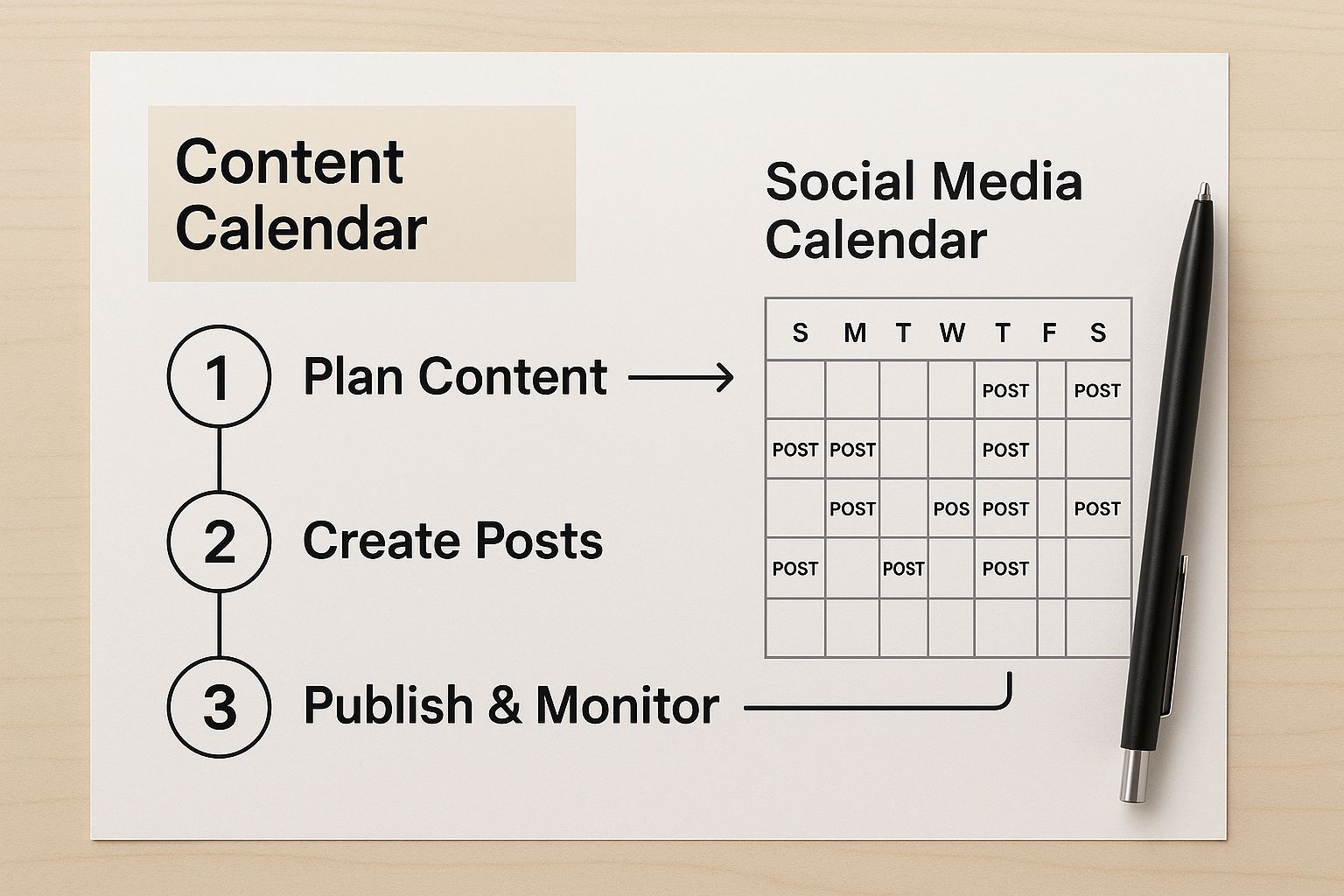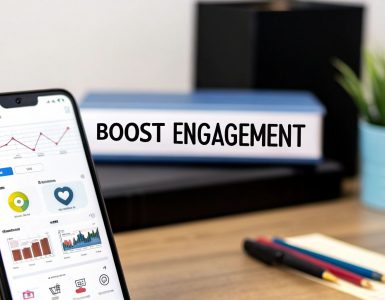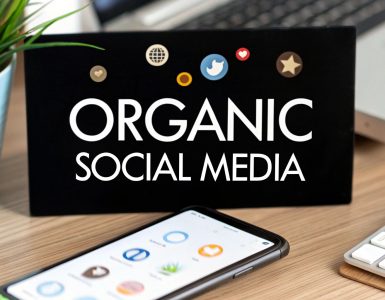Posting on social media without a plan is like navigating without a map—you're moving, but you have no idea where you're going. A small business social media strategy is what turns that random activity into a powerful engine for growth, connecting casual followers with your real business goals.
It's the documented roadmap that ensures every post, every comment, and every minute you spend on social media is actually building something valuable.
Why a Social Strategy Is Non-Negotiable

Let's be real. For most small business owners, "winging it" on social media isn't a strategy—it's just a gamble with your brand's reputation and potential income. Social media often feels like one more thing on an endless to-do list, somewhere after payroll, inventory, and keeping the lights on. But that "I'll post when I can" approach has some serious hidden costs.
Think about it this way: a local bakery posts sporadically, sharing blurry phone snaps of pastries only when they remember to. A few blocks away, a competitor is active daily. They're posting fun behind-the-scenes videos, introducing their bakers, and running polls asking customers what new flavor they should try next.
Over time, that second bakery builds a vibrant online community. They become the neighborhood's go-to spot not just for good bread, but for a friendly, engaging experience. The first bakery, even with equally delicious products, slowly fades into the background. Why? Because they're invisible where their customers are spending their time.
And this isn't just a problem for cafes or retail shops. A B2B consulting firm or a specialized contractor can lose out just as easily. When a potential client needs a local web designer, their first move is often to check Instagram or Facebook to see their work and get a feel for their style. An inactive or unprofessional-looking page is a red flag, and they'll quickly move on to a competitor who looks more credible and engaged.
The Real Cost of Inconsistency
Treating social media as a low-priority task means you're not just missing out on potential sales; you're missing the critical moments where customers discover you. Word-of-mouth is still king for small businesses, but today, that "word" spreads online. If you're not there, you're essentially handing market share over to your more strategic competitors.
It’s a tough pill to swallow, but many customers now find new products and services almost exclusively through social platforms. That's where they make their initial judgments before ever deciding to buy.
Your social media presence is your digital storefront. If the lights are off and the shelves look dusty, people will assume you're closed for business—even if your physical doors are wide open.
A huge part of any successful small business social media strategy is understanding how to earn from social media and see a return on your effort. Without a plan, you can't connect your activity to actual revenue, making it impossible to justify the time you're putting in.
Strategy vs. No Strategy: A Small Business Comparison
The difference between having a plan and just posting randomly is stark. A documented strategy brings clarity, efficiency, and measurable results. Flying blind leads to wasted time, frustration, and missed opportunities.
Here’s a quick look at how the two approaches directly affect your business.
| Business Outcome | With a Strategy | Without a Strategy |
|---|---|---|
| Brand Perception | Consistent, professional, and trustworthy. | Inconsistent, amateur, and unreliable. |
| Lead Generation | A predictable funnel for new inquiries. | Random leads with no clear source. |
| Customer Loyalty | Builds a strong, engaged community. | Fails to nurture customer relationships. |
| Time Management | Efficient, with batching and scheduling. | Haphazard, stressful, and time-consuming. |
| ROI Measurement | Clear data to prove what's working. | Guesswork with no performance insights. |
Ultimately, a documented small business social media strategy isn't about creating more work. It’s about making the work you already do count. It makes sure every post has a purpose, every interaction builds trust, and every hour spent contributes directly to your bottom line. It's one of the most powerful, cost-effective marketing assets you have.
Getting Your Bearings: Set Goals and Truly Know Your Audience
Before a single post goes live, we need to talk about what success actually looks like for your business. Firing off content without a clear goal is like driving without a destination—you're burning gas, but you aren't getting anywhere. The whole foundation of a smart social media plan is moving past flimsy "vanity metrics" and setting goals that actually help your bottom line.
Forget obsessing over follower counts. Instead, let's talk real business impact. What do you really want social media to do for you? Maybe it’s pulling 20% more traffic to your website next quarter. Or perhaps it's about generating 15 solid, qualified leads every single month. Those are the kinds of goals that make a difference.
This kind of strategic thinking isn't just a nice-to-have. Marketers who set concrete goals are a whopping 376% more likely to call their efforts a success compared to those who just wing it. Just as important is knowing your audience on a deeper level—beyond the basics—to make sure what you're saying actually lands. You can get more perspective on how strategy drives results by checking out these social media marketing insights on sprinklr.com.
What Are We Trying to Accomplish Here?
Think of your goals as your strategic North Star. They'll dictate the kind of content you create, the platforms you focus on, and how you'll ultimately measure if any of this is working. A great place to start is by tying your social media efforts directly to your bigger business ambitions.
Here are a few examples of what solid, measurable goals can look like:
- Boost website referral traffic from social channels by 25% within the next six months.
- Generate 10 new B2B leads per month through LinkedIn content and outreach.
- Drive a 15% increase in online sales for a specific product using targeted Instagram ads.
- Grow our email list by 200 subscribers by running a social media giveaway.
See the pattern? These goals are effective because they follow the S.M.A.R.T. framework (Specific, Measurable, Achievable, Relevant, and Time-bound). They cut through the fluff and give you a clear benchmark to aim for.
My Two Cents: Don't try to boil the ocean. Start with one or two primary goals. Chasing everything at once is a surefire way to get overwhelmed and burn out. Once you've got a rhythm going and see some wins, then you can start layering on more objectives.
Getting to Know Your People
Once you know what you're aiming for, it's time to figure out who you're talking to. And I mean really figure them out. Knowing your audience isn't just about their age and zip code; it’s about crawling inside their world. What problems keep them up at night? What are they passionate about? What headache are they trying to get rid of that your business can solve?
This is where building out detailed audience personas is an absolute game-changer. A persona is basically a character sketch of your ideal customer, pieced together from real data and a bit of informed market research.
To get started, pull information from a few key places:
- Your Own Customer Files: Dig into your sales records and CRM. What do your best customers have in common? Look for patterns in job titles, industries, or purchase histories.
- Social Media Analytics: Your platform's built-in tools, like Meta Audience Insights, are goldmines. They'll show you the demographics, interests, and even other pages your current followers engage with.
- Real Conversations: This one is huge. Never underestimate the power of just talking to your customers. Ask them about their biggest challenges, what they care about, and why they picked you over the other guy.
Beyond Demographics: The "Why" Behind the Buy
Moving past the basic "who" and into the "why" is what separates a decent strategy from a truly great one. You need to get into psychographics—the attitudes, values, and motivations that drive your audience's behavior.
Let's imagine you run a local, eco-friendly cleaning service. Here’s how you could build a persona:
| Persona Element | Details for "Sustainable Sarah" |
|---|---|
| Demographics | Age 30-45, suburban homeowner, has young kids, household income of $80k+. |
| Pain Points | She’s worried about using harsh chemicals around her kids and pets. She's tired of spending her precious weekends cleaning. |
| Motivations | She values health, sustainability, and feels good about supporting local businesses. She wants a clean home, minus the guilt. |
| Social Habits | She’s active in local mom groups on Facebook and follows home organization and green-living influencers on Instagram. |
Armed with this deep understanding of "Sustainable Sarah," your content plan practically writes itself. You're no longer just posting about "clean homes." You're creating posts about non-toxic cleaning tips for families with pets, showing off your plant-based products, and sharing glowing reviews from other parents in the neighborhood. This laser-focused approach makes your message hit home, building a community of loyal customers who feel like you truly get them.
Choosing Your Platforms and Content Pillars
Trying to be everywhere at once on social media is a classic mistake. I see it all the time with small business owners—it's the fastest way to burn yourself out. Instead of spreading your limited resources thin, a truly effective social media strategy is about making smart, deliberate choices.
The real goal isn't to plant a flag on every platform; it's to show up where your ideal customers are already hanging out. This focused approach means you can create much better content that actually connects with people, rather than just blasting posts into the void.
Let's be real, the digital world is noisy. Social media usage is through the roof, with 5.31 billion users globally—that's a staggering 94% of all internet users. The average person juggles nearly seven different social networks every month. For small businesses, this chaos makes platforms built on short-form video, like TikTok and Instagram Reels, incredibly important. In fact, 78% of people now say they prefer to learn about new products through video.
Picking the Right Battleground
Every social platform has its own vibe, its own audience, and its own unwritten rules. The trick is to match a platform's strengths with your specific business goals and the customer you're trying to reach.
Here’s my take on the main players from a small business perspective:
- Facebook: Still a heavyweight, especially for local businesses. It's fantastic for building community (think local Facebook Groups), running laser-focused ads, and sharing your business updates and events. It's a no-brainer for most businesses with a broad local audience.
- Instagram: This is the visual playground. If your business has strong aesthetic appeal—restaurants, boutiques, artists, designers—this is your spot. Stories and Reels are your best friends for showing off your brand’s personality and giving people a peek behind the curtain.
- TikTok: The land of short, snappy, and entertaining video. The audience here skews younger and they value creativity and authenticity over polished, corporate-style content. If your brand can be fun, helpful, or just plain entertaining in under 60 seconds, TikTok can deliver incredible organic reach.
- LinkedIn: The B2B professional zone. If your customers are other businesses, you need to be here. It’s the perfect place to share industry knowledge, connect with decision-makers, and build your credibility as an expert.
- X (formerly Twitter): It’s a firehose of information. Great for real-time updates, quick-response customer service, and jumping into conversations happening in your industry. If you’re hunting for new leads, our guide on https://www.evergreenfeed.com/blog/6-ways-can-get-new-customers-using-twitter/ has some killer tips.
My Advice: Don't try to do it all. Start with one or two platforms and truly master them. Focus on building a real community. Only after you have a system that works should you even think about adding another channel to the mix.
Defining Your Content Pillars
Okay, you’ve picked your platform(s). Now, what on earth are you going to talk about? This is where your content pillars come in. Think of these as the 3-5 core themes or topics your brand will own. They're the bedrock of your content strategy, making sure everything you post is focused, relevant, and consistent.
Your pillars should live at the intersection of what you're an expert in and what your audience genuinely cares about. Getting this right is the key to creating a content calendar that works.

When you have solid pillars, you have a roadmap. It ensures you always have a steady stream of relevant ideas ready to go.
A Coffee Shop Content Pillar Example
Let's make this real. Imagine you run a local coffee shop called "The Daily Grind." You know your customers love great coffee, supporting local spots, and finding a cozy corner to work or meet a friend.
From that, you can build out some powerful content pillars:
| Content Pillar | Description | Example Post Ideas |
|---|---|---|
| Coffee Education | Show off your expertise and the quality of what you sell. | How-to reel on brewing the perfect pour-over. A carousel post on the origin story of your beans. Fun facts about different roast levels. |
| Behind the Scenes | Put a human face to your brand and show the people behind the magic. | "Meet the Barista" spotlights. A time-lapse of the morning rush. A quick video of you taste-testing a new seasonal syrup. |
| Community Hub | Position your shop as more than just a place to get coffee. | Posts featuring the local artist whose work is on your walls. A story promoting the weekend farmers market next door. Sharing tagged customer photos (with permission!). |
| Promotions & New Items | Drive sales and get people excited to visit. | Announcing a "two-for-one" latte special on a slow afternoon. Introducing a new pastry from that amazing local baker. The big launch of your fall seasonal menu. |
Once you define these pillars, that feeling of staring at a blank calendar and wondering what to post completely disappears. You have a framework that not only guides your content but constantly reinforces what makes your brand special.
As you get more comfortable, you can explore advanced tactics like partnering with influencers. For businesses ready to scale their reach, working with top influencer marketing agencies can be a game-changer.
Building Your Evergreen Content Engine
Let's be honest. The social media content treadmill is exhausting. For a small business owner, the pressure to churn out new posts every single day is a one-way ticket to burnout. This is where you stop working harder and start working smarter by building a small business social media strategy around timeless, high-value assets.
The big secret? Shift your focus from chasing fleeting trends to creating a solid library of evergreen content. Think of it like this: a newspaper is useful for a day, but a solid reference book holds its value for years. Your social media needs that reference book section—the foundational content that will save your sanity and drive results long-term.
Timeless Value Over Chasing Trends
Evergreen content is simply material that stays relevant and helpful to your audience way past its original publication date. It tackles the fundamental questions, solves the nagging problems, and shares core truths about your industry. Unlike that post about a flash-in-the-pan meme, an evergreen piece has a seriously long shelf life.
This is the stuff that becomes the real workhorse of your social media. You can repurpose and reshare it for months, even years, and it never feels dated. Before you know it, you’ve built an impressive library that works for you 24/7, taking the daily pressure off.
Your evergreen content library is your greatest marketing asset. It’s a collection of high-value resources that continuously attracts, educates, and builds trust with your audience, even when you’re focused on other parts of your business.
This is a mindset shift from creating posts to creating assets. For instance, think about a single, common customer question. Let's say you run a landscaping business and people constantly ask, "When is the best time to prune roses?"
You can spin that one question into a whole content ecosystem:
- A detailed blog post on your website that becomes the definitive guide.
- A short video tutorial for Instagram Reels or TikTok actually showing your pruning technique.
- A carousel post for Facebook breaking down the process into quick, digestible tips.
- An infographic that visually lays out the do's and don'ts of pruning.
Just like that, one idea has generated a week's worth of valuable, diverse content you can schedule and reuse later. If you need a little help getting the ideas flowing, check out this ultimate list of evergreen content ideas to kickstart your brainstorm.
Mastering the Art of Batch Creation
So, you see the power of evergreen content. But how do you actually find the time to create it all? The answer is batch creation. It’s a beautifully simple concept: set aside a dedicated block of time to produce a ton of content all at once, instead of scrambling to make something new every day.
Imagine dedicating one afternoon to creating an entire month’s worth of social media posts. It’s a complete game-changer, especially when you're juggling a million other things.
Here’s what a practical batching session could look like:
- Brainstorm & Outline: Drawing from your main content pillars, jot down 10-15 evergreen topics. Think FAQs, common myths in your industry, simple how-to guides, or behind-the-scenes stories.
- Create the Core Content: Now, focus on one task at a time to get into a good flow. Write all the captions. Then, film all your videos. After that, design all your graphics.
- Organize Your Assets: Keep your sanity by saving everything in clearly labeled folders. A simple naming system like "RosePruning_Tips_Instagram_May2024" makes finding things a breeze.
- Schedule Everything: This is where the magic happens. Plug all your finished content into a scheduling tool. Your hard work is now a hands-off, consistent social media presence.
This process turns social media from a reactive, daily chore into a proactive, strategic part of your business. It frees up your brainpower so you can focus on what really matters—engaging with your community and actually running your company.
Getting Your Social Media Workflow on Autopilot

You've put in the work to create a fantastic library of evergreen content. That's your secret weapon against social media burnout. But all that great content doesn't do you any good just sitting in a folder. This is where a little smart automation can turn your small business social media strategy from a daily grind into a well-oiled machine.
Let's be clear: automation isn't about "faking it" or being impersonal. It's about being strategic with your most limited resource—your time. It handles the repetitive task of manually posting every single day, freeing you up for the stuff that actually moves the needle, like talking to your customers and building real relationships. Think of it as hiring a super-efficient assistant who works 24/7.
I know what you're thinking: "But I don't want to sound like a robot!" You won't. The trick is to automate the scheduling, not the engagement. You're simply telling a tool to share your pre-written, high-value content at the best times. The human touch is all you—showing up to reply to comments and join the conversations your posts create.
How to Put Your Content on a Loop
To make this happen, you need a tool built for the job. A platform like EvergreenFeed is designed specifically to take your library of evergreen posts and put them on a continuous, automated cycle. This is how you transform those assets you batch-created into a consistent, lively social media presence.
Getting started is surprisingly simple. The first thing you'll do is organize all that content you created—your blog post links, quick tips, behind-the-scenes shots, and promos—into different categories. Some people call them "buckets." This step is absolutely key to making sure your feed looks balanced and natural, not just like a constant sales pitch.
For instance, your content buckets might look something like this:
- Educational Posts: Your how-to's, industry explainers, and myth-busting tips.
- Promotional Content: Posts that talk about your products, services, or current sales.
- Behind the Scenes: Content that builds community, like team spotlights, office tours, and questions for your audience.
- Brand Stories: Posts that share your company's "why," your core values, and the people who make it all happen.
Once your content is sorted, you build a schedule. You can literally tell the tool, "Share something from my Educational bucket every Monday and Wednesday, a Promotional post on Friday, and a Behind the Scenes post every Tuesday." The system then intelligently grabs a post from the right category and publishes it for you. It's that easy.
My Two Cents: Automation is the engine of your strategy, but real, human engagement is its soul. The point isn't to set it and forget it. The goal is to put content distribution on autopilot so you can reinvest your time in having authentic conversations with your community.
Marrying Automation with Authentic Engagement
A killer social media presence is a delicate dance between automated consistency and genuine, in-the-moment interaction. While your scheduling tool is the reliable workhorse pushing content out, your job is to be present and responsive. This hybrid approach is the secret sauce for an effective and manageable small business social media strategy.
Picture this: your scheduler automatically posts a helpful tip. A few hours later, a follower leaves a comment asking a great follow-up question. That's your cue. By jumping in with a thoughtful, personal reply, you show there's a real person behind the account who's listening and cares. These are the interactions that build loyalty and turn casual followers into true fans.
Here’s how I've seen small businesses nail this balance:
- Carve out engagement time. You don't need to be glued to your phone. Just block out 15-20 minutes a couple of times a day—maybe once in the morning with your coffee and again in the afternoon—to check notifications and reply to comments and DMs.
- Keep an eye on your mentions. Use your platform's search tools to see who's talking about your brand, even when they don't @ you. A quick "Hey, thanks for the shout-out!" can make someone's day.
- Be part of the conversation. Don't just wait for people to engage with you. Spend a few minutes commenting on posts from your customers, other local businesses, and leaders in your industry.
This powerful combination of smart automation and dedicated engagement is the most sustainable path to social media success for a small business. It keeps your brand visible without eating up your entire day, all while you focus on building the genuine connections that actually grow your bottom line.
Measuring What Matters and Refining Your Plan
You’ve built your strategy, created a library of fantastic evergreen content, and even put your posting schedule on autopilot. So, what now? The big question is: how do you know if any of it is actually working?
This is the exact point where I see so many small businesses drop the ball. A truly effective small business social media strategy doesn't stop once the posts go live. The real work—and the real value—comes from closing the loop with measurement.
It’s tempting to get caught up in the easy wins, what we often call "vanity metrics." A sudden spike in likes or a fresh wave of followers feels great, but those numbers rarely tell the whole story. Let’s be honest, they don’t pay the bills. The goal is to zero in on the key performance indicators (KPIs) that actually signal business growth.
Focusing on Business-Centric KPIs
Instead of just chasing likes, it’s time to track the metrics that connect your social media activity directly to your bottom line. These are the numbers that prove your efforts are bringing tangible value to your company.
So, what should you really be looking at?
- Click-Through Rate (CTR): This is the percentage of people who saw your post and actually clicked the link. A strong CTR is a clear sign that your copy and creative are compelling enough to make people take that next step.
- Website Referral Traffic: Fire up your Google Analytics. Here, you can see exactly how many visitors are landing on your website from each social platform. This is a direct measure of how well your social presence is driving genuine interest in your business.
- Lead Form Completions: If your goal is generating leads, you need to track how many people who arrived from social media actually filled out your contact or "request a quote" form. This is a hard number that shows you're not just getting traffic, but attracting potential customers.
- Conversion Rate: This is the big one. It tracks the percentage of visitors from social media who complete a desired action, like making a purchase or signing up for your email list.
Shifting your focus to these KPIs transforms social media from a "nice-to-have" marketing activity into a measurable, performance-driven channel. You can finally see which posts aren't just popular, but actually profitable.
Your Monthly Strategy Check-Up
Your social media plan should never be set in stone. I like to think of it as a living document—one that needs a regular check-up to stay healthy and effective. A simple monthly or quarterly review is all it takes to make sure you're still on the right path.
This doesn't have to be some complex, drawn-out process. Just block out an hour to dive into your analytics. Most platforms, from Facebook to Instagram, have incredibly robust and free tools that provide all the data you need.
Your social media analytics are a treasure map. They tell you exactly where the gold is buried—which content pillars are resonating, which posts are driving traffic, and where your audience is most engaged. Ignoring this data is like trying to navigate without looking at the map.
During your review, ask yourself a few critical questions:
- Which content pillars performed best? Did your "Behind the Scenes" posts get more clicks than your "Educational" ones? This tells you exactly what your audience wants more of.
- What was our top-performing post? Find it and dissect it. Was it a video? A carousel? Did it have a specific call-to-action? Figure out what made it successful so you can replicate that magic.
- Are we on track to hit our goals? Look back at those S.M.A.R.T. goals you set. Are your website traffic or lead numbers where they need to be?
This cycle of regular analysis and refinement is what separates a static, ineffective plan from a dynamic one that evolves with your audience. For a deeper dive into this, our guide on how to measure social media ROI offers an excellent framework for connecting your efforts to real financial returns.
Making small, data-driven tweaks based on these insights—like creating more of what works and dialing back on what doesn't—is how you compound your success over time. This continuous feedback loop ensures your small business social media strategy remains a powerful, results-driven engine for your growth.
Ready to put your evergreen content strategy on autopilot and save hours every week? EvergreenFeed automates your posting schedule so you can focus on what really matters—growing your business. Sign up for free and see how easy it is.




